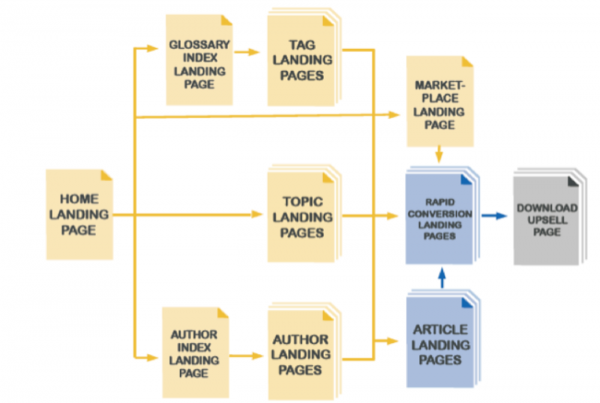Landing page optimization requires a solid knowledge of the types of landing pages out there, including their website architecture, design, online copywriting and direct response testing
The first thing you need in order to create great landing pages is a basic understanding of the types of landing page templates used by publishers. With that in mind, your odds of increasing landing page conversion rates will definitely improve.
When most people talk about landing pages, they really mean sales letter landing pages – which from our perspective are just one of several types of landing pages publishers use to build high conversion websites. Mequoda and its clients require a far more specific understanding of landing pages and their function on a subscription website. To build traffic and convert traffic into a large email list of loyal customers – the foundation of the Mequoda Method – you must deploy each one of the landing pages correctly.
[text_ad]
Consider every page on your website to be a landing page with the goal of converting the web visitor into an email subscriber or buyer.
An organic landing page is designed to attract website traffic and convert visitors into subscribers. Publishers use organic landing pages when they can’t control where the user is going to enter (or “land on”) the website.
A conversion landing page has the primary purpose of creating a transaction. They can coincidentally attract organic traffic, but are dedicated to converting traffic, regardless of the source. Generally traffic arrives at conversion landing pages via links from sources the publisher controls, such as PPC (pay-per-click), affiliate advertising, or paid advertising.
In any basic Mequoda System, you’ll find these ten landing pages within the architecture. In yellow, you’ll find your soft-sell landing pages that are optimized for organic search but do not directly initiate a transaction. The one major thing you’ll notice is that all paths lead to the Rapid Conversion Landing Page, which is the page we consider to be the queen bee of all your landing pages – this is the landing page that converts visitors into email subscribers. And because of it, every page of your site points to it. (Except the download upsell page, which is the page a user sees after they’ve downloaded the free report – and it upsells to a paid product.)

[text_ad]
Organic landing pages must first attract and then convert, hence website designers insert things like OFIEs (order forms in editorial), OFINs (order forms in navigation), floaters, text ads and simple text links to start the conversion process.
There are are seven types of Organic Landing Pages Mequoda has identified, each with its own unique information architecture designed to pull traffic in via search engine optimization and then initiate a transaction through a call to action through 3C architecture.
The seven types of basic organic landing pages are:
- Home Landing Page: the home page of your portal.
- Topic Landing Pages: pages that list articles from one topic you publish articles about, also called categories.
- Glossary Index Landing Pages: landing pages with a list of tags, which link to complete tag pages and definitions.
- Tag Landing Pages: landing pages that feature one keyword tag and includes a definition along with all posts using the same tag.
- Author Index Landing Page: landing pages that feature all of the authors on your site, which link to their individual author pages.
- Author Landing Pages: landing pages that feature one author, include a bio, and also a linked list of recently published articles.
- Article Landing Pages: any one article with narrative content, like what you’re reading right now. This is the landing page most search visitors will arrive on.
- Marketplace Landing Pages include your product showcase. This is an index of all your Rapid Conversion Landing Pages or Sales Letter Landing Pages. Our research has shown images of each item, even download-only products, improves conversion rates.
Next, the RCLP queen bee mentioned earlier stands on its own here – this is is a conversion landing page you will develop to promote a free product. It will be linked to from all of the pages above in order to tell Google you think this is one of your most important portal pages.
- Rapid Conversion Landing Pages (RCLPs) are used to entice a user to enter into a low-risk, low-friction transaction. This type of landing page is used when there is no cost to the user (a free offer) or when payment is delayed and includes options (a bill-me later offer).
Once the transaction is complete, we recommend developing an Upsell Landing Page.
- Download Upsell Landing Pages are specialized landing pages that offer the user an additional product or service as part of the process and acknowledges a prior transaction. They are highly effective when properly executed, delivering conversion rates as high as 20 to 30 percent, depending on the offer.
Let us know what you think about the basic definitions and how they match or don’t match the way you think about landing page-driven Internet marketing.
This article was originally written in 2006 and is updated frequently.



Hi Ted,
Sorry about that, this article is from 2006 and it looks like we lost the images when we updated the site. I just went in and linked the pages to their glossary pages and articles which many have images. You can also find longer descriptions and images in this white paper which is much more recent: http://www.mequoda.com/free-reports/master-landing-page-templates/
Thanks for reading!
The images of the landing pages are missing in both Chrome and Firefox. Internet Explorer doesn’t even find this page.